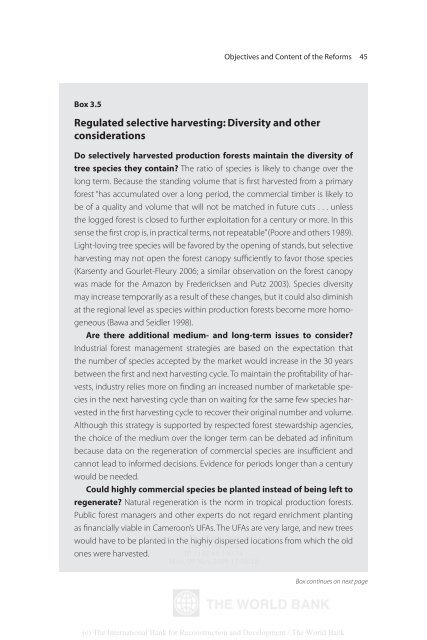The Rainforests of Cameroon - PROFOR
The Rainforests of Cameroon - PROFOR
The Rainforests of Cameroon - PROFOR
- No tags were found...
You also want an ePaper? Increase the reach of your titles
YUMPU automatically turns print PDFs into web optimized ePapers that Google loves.
Objectives and Content <strong>of</strong> the Reforms 45Box 3.5Regulated selective harvesting: Diversity and otherconsiderationsDo selectively harvested production forests maintain the diversity <strong>of</strong>tree species they contain? <strong>The</strong> ratio <strong>of</strong> species is likely to change over thelong term. Because the standing volume that is first harvested from a primaryforest “has accumulated over a long period, the commercial timber is likely tobe <strong>of</strong> a quality and volume that will not be matched in future cuts . . . unlessthe logged forest is closed to further exploitation for a century or more. In thissense the first crop is, in practical terms, not repeatable” (Poore and others 1989).Light-loving tree species will be favored by the opening <strong>of</strong> stands, but selectiveharvesting may not open the forest canopy sufficiently to favor those species(Karsenty and Gourlet-Fleury 2006; a similar observation on the forest canopywas made for the Amazon by Fredericksen and Putz 2003). Species diversitymay increase temporarily as a result <strong>of</strong> these changes, but it could also diminishat the regional level as species within production forests become more homogeneous(Bawa and Seidler 1998).Are there additional medium- and long-term issues to consider?Industrial forest management strategies are based on the expectation thatthe number <strong>of</strong> species accepted by the market would increase in the 30 yearsbetween the first and next harvesting cycle. To maintain the pr<strong>of</strong>itability <strong>of</strong> harvests,industry relies more on finding an increased number <strong>of</strong> marketable speciesin the next harvesting cycle than on waiting for the same few species harvestedin the first harvesting cycle to recover their original number and volume.Although this strategy is supported by respected forest stewardship agencies,the choice <strong>of</strong> the medium over the longer term can be debated ad infinitumbecause data on the regeneration <strong>of</strong> commercial species are insufficient andcannot lead to informed decisions. Evidence for periods longer than a centurywould be needed.Could highly commercial species be planted instead <strong>of</strong> being left toregenerate? Natural regeneration is the norm in tropical production forests.Public forest managers and other experts do not regard enrichment plantingas financially viable in <strong>Cameroon</strong>’s UFAs. <strong>The</strong> UFAs are very large, and new treeswould have to be planted Delivered in the by <strong>The</strong> highly World dispersed Bank e-library locations to: from which the old<strong>The</strong> World Bankones were harvested. IP : 192.86.100.34Mon, 09 Nov 2009 17:06:18Box continues on next page(c) <strong>The</strong> International Bank for Reconstruction and Development / <strong>The</strong> World Bank
















